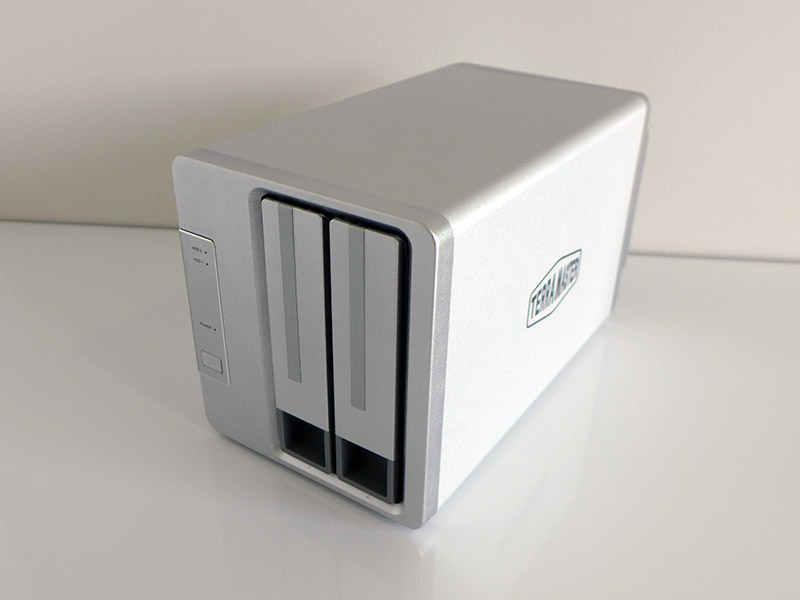 While Networked RAID devices are a dime a dozen, Direct Attached Storage (DAS) RAID units are a rarer breed. And Terra Master’s D2-310 has a leg up on the competition: This box attaches via USB-C.
While Networked RAID devices are a dime a dozen, Direct Attached Storage (DAS) RAID units are a rarer breed. And Terra Master’s D2-310 has a leg up on the competition: This box attaches via USB-C.
Read on as we take a look at Terra Master’s dual bay DAS RAID device.
Direct Attached Storage or DAS simply refers to any storage device that is directly attached to a computer. In essence, a USB “flash/thumb drive” is a DAS device, although for reasons unknown, we almost never refer to them this way.
RAID on the other hand is a way of storing data on a “Redundant Array (of) Independent/Inexpensive Disks.” Depending on which RAID level you use, you can store data with a view to increase data throughput (RAID 0) or to improve failure recovery through data redundancy (RAID 1, 5, 6 and 10). If you want more information on RAID and its various levels Wikipedia is a good starting point.
UNBOXING
 The Terra Master D2-310 comes complete with everything you need to get up and running straight away. Not only does the unit come complete with the standard power plugpack and ubiquitous sundry paperwork but Terra Master also includes a handy reset pin as well as a USB-C to USB-A cable. Beyond this, two small bags of mounting screws are included as is a small flat head screw driver.
The Terra Master D2-310 comes complete with everything you need to get up and running straight away. Not only does the unit come complete with the standard power plugpack and ubiquitous sundry paperwork but Terra Master also includes a handy reset pin as well as a USB-C to USB-A cable. Beyond this, two small bags of mounting screws are included as is a small flat head screw driver.
The D2-310 has a relatively svelte footprint at 12 x 23 x 13.5cm and the unit’s outer casing is mostly made up of silver aluminium capped with a textured silver plastic front and rear. The front face is dominated by two drive bays located to the right (neatly off centre) which is complemented by a small brushed aluminium panel to the left. This panel has three LEDs; one for power and one for each drive bay beneath which is a rectangular power button.
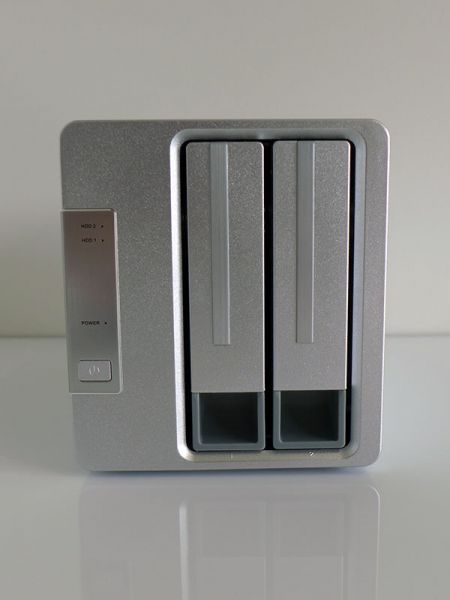 The rear of the unit has a 8x8cm fan located to the left side matching the location of the two front drive bays. Worth noting is that the fan protrudes from the main casing by just under 2cm and is completely encased in the same silver textured plastic as the front. To the right of the fan is a paperclip reset button, a manual RAID selector switch (more on this later), the all important USB-C connector and a 12V DC in port.
The rear of the unit has a 8x8cm fan located to the left side matching the location of the two front drive bays. Worth noting is that the fan protrudes from the main casing by just under 2cm and is completely encased in the same silver textured plastic as the front. To the right of the fan is a paperclip reset button, a manual RAID selector switch (more on this later), the all important USB-C connector and a 12V DC in port.
The top and sides of the unit are unremarkable other than a centrally located Terra Master logo printed centrally on each side. The base of the unit features some linear breathing holes along with four rubber legs.
SETUP AND USAGE
To test the D2-310 we populated the drive bays with two old Western Digital RE2 500GB hard disk drives. While the drives screwed in firmly with the supplied screws, we did find there was some sideways play in the drive bays even after they were clicked in. While the drive bay caddies matched the front fascia, the mechanism employed was quite rudimentary. The drives did click in securely but contained no key lock system.
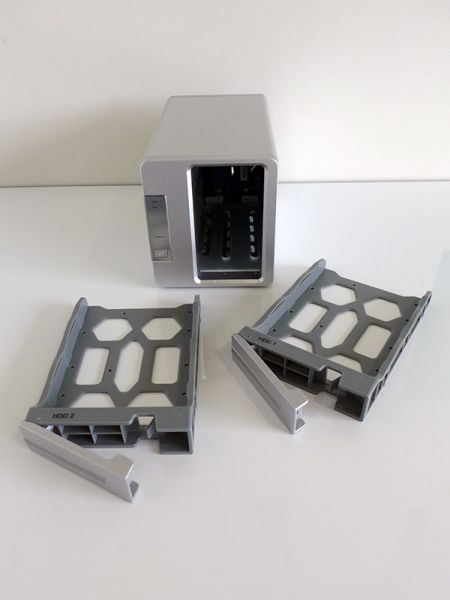 Having inserted both drive bay caddies we turned to the back of the D2-310 and using the included screw driver, selected RAID 0 on the dial before connecting the D2-310 up to our USB-C (only) MacBook Pro. Unlike most RAID devices we have tested, the D2-310 employs a physical dial to select RAID levels.
Having inserted both drive bay caddies we turned to the back of the D2-310 and using the included screw driver, selected RAID 0 on the dial before connecting the D2-310 up to our USB-C (only) MacBook Pro. Unlike most RAID devices we have tested, the D2-310 employs a physical dial to select RAID levels.
Along with JBOD, RAID 0 and RAID 1, the D2-310 also supports a single disk mode where RAID mode known as JBOD which when working with two disks (for the purpose of this article), is much the same as RAID 0.
Worth noting is that the selector dial could not be operated accidentally as the recessed dial can only be turned via the use of a small flat head screw driver (or similar device).
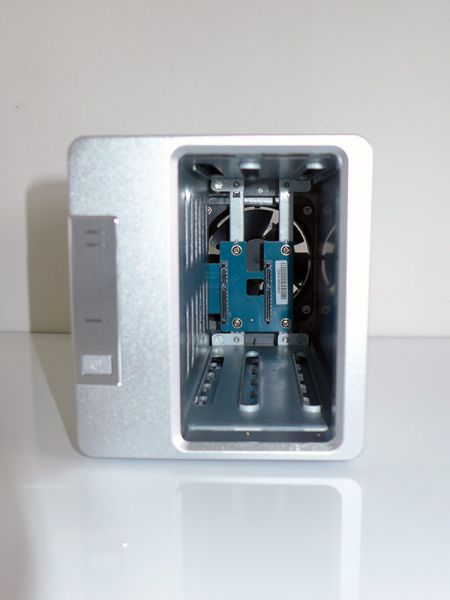 We conducted the bulk of our testing with both our late 2016 13” MacBook connected up to the D2-310 via Terra Master’s USB-C to USB-A cable (along with Apple’s USB-C to USB-A dongle). Please note that while two USB cables are pictured, the current retail package only comes with one USB-C to USB-A cable.
We conducted the bulk of our testing with both our late 2016 13” MacBook connected up to the D2-310 via Terra Master’s USB-C to USB-A cable (along with Apple’s USB-C to USB-A dongle). Please note that while two USB cables are pictured, the current retail package only comes with one USB-C to USB-A cable.
Once the D2-310 was powered on, a dialogue box appeared on our MacOS 10.12.6 system asking us to initialise the new disk. After okaying this process we headed into Disk Utility and formatted the D2-310’s RAID 0 array to Apple’s HFS+ file system.
Within seconds the drive appeared on our desktop just like any other external USB drive. Easy.
To test the performance of the D2-310’s reading and writing speed we ran some standardised tests we usually undertake on NAS devices, including transfers of both large files and folders of small ones. These tests were undertaken via finder and timed manually. Beyond this we used the legacy AJA System Test software. These tests were all run from a Late 2016 13” MacBook Pro connected via Terra Master’s USB-C to USB-A cable and an official Apple USB-C to USB-A dongle.



Throughout our month or so of general usage, we found the D2-310 worked flawlessly, storing and transferring our data without issue. Sitting on a desk, the D2-310 was audibly noticeable but not grating or annoying. It is no small irony that what makes the fan noise noticeable is the complete absence of noise coming from the MacBook Pro!
While Terra Master’s quoted 20W power draw is quite economical, the D2-310 also turned off its fan and hard drives after around 10 minutes of inactivity, effectively reducing the noise level to zero when in standby.
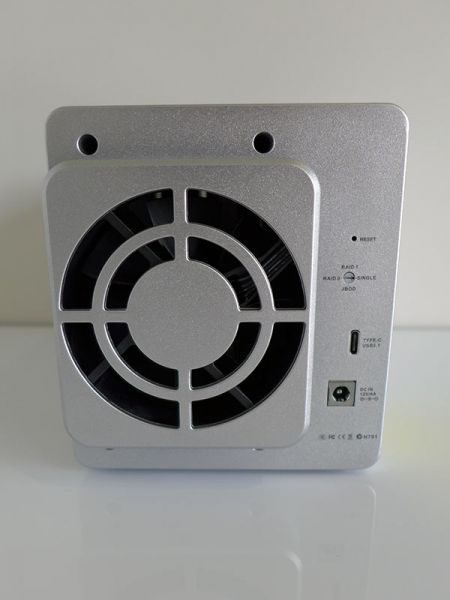 SELECTED SPECIFICATIONS
SELECTED SPECIFICATIONS
Drive Bays: 2
Compatible Drive Type: 3.5” or 2.5”
RAID Support: Single Disk, JBOD, RAID 0 and RAID 1
Maximum Internal Raw Capacity: 20TB (2x 10TB)
External Ports: 1x USB-C 3.1
Supported OS: Windows and MacOS
Dimensions: 227 x 119 x 133mm
Weight (net): 1.3kg
Power Consumption (access): 20W
Warranty: 2 Years
CONCLUSION
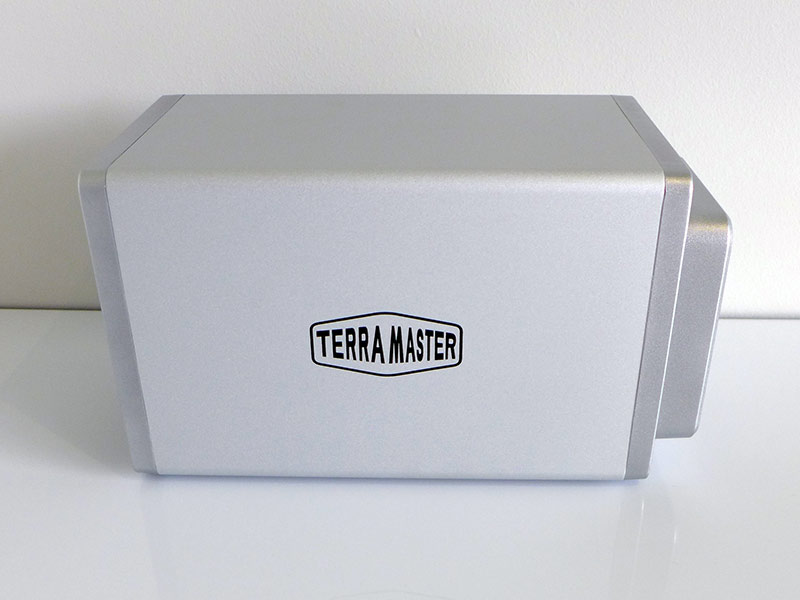 The D2-310 is a neat little unit which performed solidly both in testing and general usage. While we didn’t see the peak numbers suggested in the marketing, our use of old drives may have affected transfer speeds. Of course, having said this, these transfer speeds were certainly very good!
The D2-310 is a neat little unit which performed solidly both in testing and general usage. While we didn’t see the peak numbers suggested in the marketing, our use of old drives may have affected transfer speeds. Of course, having said this, these transfer speeds were certainly very good!
The D2-310 is available now for just over 150UK Pounds from the Amazon marketplace and for more information please visit Terra Master’s website.



